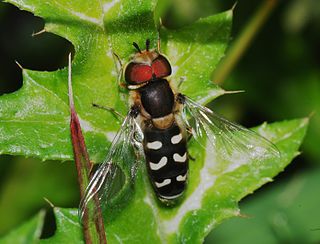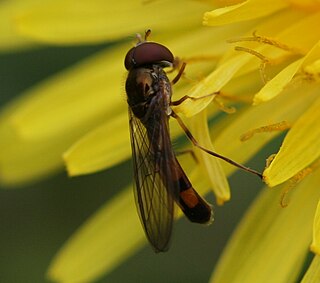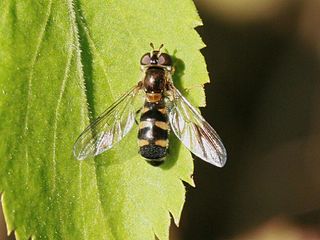
Hover flies, also called flower flies or syrphid flies, make up the insect family Syrphidae. As their common name suggests, they are often seen hovering or nectaring at flowers; the adults of many species feed mainly on nectar and pollen, while the larvae (maggots) eat a wide range of foods. In some species, the larvae are saprotrophs, eating decaying plant and animal matter in the soil or in ponds and streams. In other species, the larvae are insectivores and prey on aphids, thrips, and other plant-sucking insects.

The Sikorsky R-4 is a two-seat helicopter that was designed by Igor Sikorsky with a single, three-bladed main rotor and powered by a radial engine. The R-4 was the world's first large-scale mass-produced helicopter and the first helicopter used by the United States Army Air Forces, the United States Navy, the United States Coast Guard and the United Kingdom's Royal Air Force and Royal Navy. In U.S. Navy and U.S. Coast Guard service, the helicopter was known as the Sikorsky HNS-1. In British service it was known as the Hoverfly.

Volucella pellucens, the pellucid fly, is a hoverfly.

Rat-tailed maggots are the larvae of certain species of hoverflies belonging to the tribes Eristalini and Sericomyiini. A characteristic feature of rat-tailed maggots is a tube-like, telescoping breathing siphon located at its posterior end. This acts like a snorkel, allowing the larva to breathe air while submerged. The siphon is usually about as long as the maggot's body, but can be extended as long as 150 mm (5.9 in). This organ gives the larva its common name.

Episyrphus balteatus, sometimes called the marmalade hoverfly, is a relatively small hoverfly (9–12 mm) of the Syrphidae family, widespread throughout the Palaearctic region, which covers Europe, North Asia, and North Africa. It is considered the most abundant native hoverfly in Central Europe.

Eristalinae are one of the four subfamilies of the fly family Syrphidae, or hoverflies. A well-known species included in this subfamily is the dronefly, Eristalis tenax.

Myathropa florea, sometimes referred to as the Batman hoverfly, is a very common European and North African species of hoverfly. Adults may be seen on flowers from May to September. It is of a similar size to the common drone fly, but Myathropa are generally more yellow, with two light bands to the thorax, interrupted with a black central smudge. In museum specimens, any yellow colour soon fades to brown after death. Like most species in the tribe Eristalini, Myathropa are rather variable in size, shape and colour.

Merodon equestris is a Holarctic species of hoverfly. Like many other hoverflies it displays a colouration pattern similar to a stinging insect as an evolutionary defense mechanism. Other syrphid bee mimics are Mallota, Arctophila, Criorhina, Pocota and Brachypalpus. Merodon species are distinguished from these by the very strong hind femora, which bear a large triangular projection on the underside near the tip. It flies in low vegetation while the other bumblebee mimics prefer higher vegetation layers.

Scaeva pyrastri, common name the pied hoverfly, is a species of hoverfly.

Sphaerophoria scripta, the long hoverfly, is a species of hoverfly belonging to the family Syrphidae.

Melanostoma scalare, the chequered hoverfly, is a very common species of hoverfly.

Melanostoma mellinum is a very common species of hoverfly found in many parts of Britain, Europe including the Mediterranean basin and North Africa, the East Palearctic, and North America.

Blera fallax, the pine hoverfly or roodkapje, is a rare species of hoverfly normally associated with mature pine trees in Northern and Central Europe.

Meligramma is a genus of hoverflies in the subfamily Syrphinae.

Platycheirus fulviventris is a Palearctic species of hoverfly. It is found in many parts of Britain and Europe.

Platycheirus tarsalis is a species of hoverfly. It is found in many parts of Britain and Europe.

Lejops is a genus of hoverflies, closely related to the genera Helophilus, Quichuana and Mallota.

Microdon mutabilis, is a species of hoverfly. It is found in many parts of Britain and Europe. The distinctive almost slug-like larvae live in ants' nests. They are hemispherical in shape, heavily armoured and believed to prey on the eggs and larvae of a number of ant species, including Formica lemani, Formica fusca, Lasius niger and Myrmica ruginodis. It was described by Carl Linnaeus in his landmark 1758 10th edition of Systema Naturae.

The Sikorsky R-6 is an American light two-seat helicopter of the 1940s. In Royal Air Force and Royal Navy service, it was named the Hoverfly II.

Platycheirus ambiguus is a small widespread species of hoverfly found across the Palearctic from Ireland to Japan. A spring species found in flight in April and May, it visits spring-flowering trees and shrubs; e.g., Prunus spinosa in deciduous woodland and scrub.




















